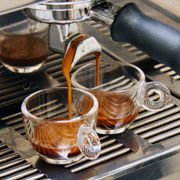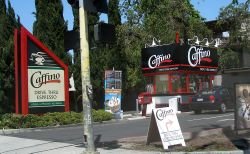Espresso
DDV CULINARY

Espresso brewing, with a dark reddish-brown foam, called crema
Espresso (Italian) is a flavourful coffee beverage brewed by forcing very hot but not boiling water under high pressure, through coffee that has been ground to a consistency between extremely fine and powder. It was invented and has undergone development in Italy since the begining of the 20th century, but up until the mid 1940s it was a beverage produced solely with steam pressure. The invention of the spring piston lever machine and its subsequent commercial success changed espresso into the beverage we know of today, produced with between 9 and 10 atmospheres, or bar of pressure. The qualitative definition of espresso includes a thicker consistency than drip coffee, a higher amount of dissolved solids than drip coffee per relative volume, and a smaller serving size known as single or double shots. (Occasionally triple or more shots may be ordered.) Espresso is chemically complex and volatile, with many of its chemical components degrading from oxidation or loss of temperature. A distinguishing factor of properly brewed espresso is the presence of crema, a reddish-brown foam which floats on the surface of the espresso. It is composed of vegetable oils, proteins and sugars. Crema has elements of both emulsion and foam colloid. As a result of the high-pressure brewing process, all of the flavors and chemicals in a typical cup of coffee are concentrated. Some people prefer a single or double shot instead of one or two cups of coffee to get a quick shot of caffeine. Also, because of its intense and highly concentrated ingredients (including caffeine) espresso lends itself to mixing into other coffee based drinks, such as lattes, cappuccinos, macchiatos, and mochas, without the need to overly dilute the resulting drink. Naming VariationsThe term espresso refers to the brewing method and combines all 3 meanings of the word express:
Ordering a coffee in Italy (un caffè), as in much of Europe, means ordering an espresso. A similar alternative, an espresso mixed with hot water, is known as caffè americano. The phrase 'American Coffee' (spoken in English) is widely understood, as is the commonly used term 'Long Black'. It is rarely ordered by Italians. Espresso
Milk
Americano
Other
Popularity
A drive-through espresso bar near Silicon Valley
Espresso is the most popular type of coffee in Argentina, Brazil, Cuba, France and southern Europe, notably Italy, Portugal and Spain, and is also popular throughout Europe, and North America. In Australia and New Zealand espresso accounts for nearly 100% of the commercial cafe, coffeehouse and restaurant coffee business. The popularity of different levels of roast in espresso vary greatly. Espresso is typically a blend of beans roasted anywhere from very light to very dark with a lot of surface oil evident. In Southern Italy, a darker roast is preferred but in Northern Italy, a more medium roast is the most popular type. Companies such as Starbucks and Peets have popularized darker roasts in North America and around the world, but the current trend in espresso coffee is matching the roast level to the bean type; this means that the most popular roast style is moving away from being associated with roast color, and more associated with what each region and type of bean used produces the best flavor extraction in the cup. A popular myth about espresso is that it is a specific bean or roast level, which is untrue. Any bean or roasting level can be used to produce authentic espresso. However, there is a more specific "espresso grind", which normally means a fine grind, somewhere between drip (a medium grind) and Turkish (a powdery grind). With the rise of coffee chains such as Starbucks, Seattle's Best Coffee, and others, espresso-based drinks rose in popularity in non-traditional markets. Hanging out at a coffee bar sipping little cups of espresso (or more often large mugs of flavored latte) became hip and trendy. The influence of Starbucks has caused a wide divergence from the Italian style of coffee, by adding syrups, whipped cream, flavour extracts, soy milk and different spices to their drinks. Long and complicated drink orders became the punchline of many jokes aimed at making fun of how finicky and obsessive coffee drinkers can be. Home espresso machines have also increased in popularity with the general rise of interest in espresso, and with the Internet and its use as a tool to spread information about this beverage around the world. Today, a wide range of high quality home espresso equipment can be found in specialty kitchen and appliance stores, online vendors, and department stores. The internet has facilitated the spread of information about a wide range of espresso-based drinks and can dispel (or promote) many myths on how to properly brew espresso. Brewing ProcessColloquially, a professional operator of an espresso machine is called a barista (Italian for a bartender), and the act of producing a shot of espresso is termed "pulling" a shot. The term "pulling" derives from lever-style espresso machines that required pulling a long handle to produce a shot. To pull a shot of espresso, a metal filter-basket is filled with either 7-10 grams or 12-18 grams of ground coffee for a single shot (30 mL) or double shot (60 mL), respectively. The espresso is then tamped, lightly or heavily (and sometimes not at all) into a densely packed puck of espresso. New baristas are often admonished to tamp with 30 lbf/in² of pressure for the sake of consistency. The portafilter (or group handle) holds the filter-basket and is locked under the grouphead's diffusion block. When the brew process begins, pressurized water at 90±5 °C (200±9 °F) and approximately 900 kPa (130 PSI) is forced into the grouphead and through the ground coffee in the portafilter. Water cooler than the ideal zone causes sourness; hotter than the ideal zone causes bitterness. High-quality espresso machines control the temperature of the brew water within a few degrees of the ideal. (The serving temperature of espresso is significantly lower, typically around 60-70 °C, owing to the small serving size and the cooling effects of the cup and the pouring process.) This process produces a rich, almost syrupy beverage by extracting and emulsifying the oils in the ground coffee. An ideal double shot of espresso should take 20-30 seconds to arrive, timed from when the machine's pump is first turned on (unless the machine has a "preinfusion" stage, which may add about 7 seconds to the process). Varying the fineness of the grind, the amount of pressure used to tamp the grinds, or the pump pressure itself can be used to bring the extraction time into this ideal zone. Most prefer to pull espresso shots directly right into a pre-heated demitasse or shot glass, to maintain the ideal temperature of the espresso and preserve all of its crema. A recent North American brewing trend came with the invention of the bottomless portafilter, that is, a portafilter without the bottom half, exposing the basket and causing the espresso to not contact any additional metal during the extraction process. The bottomless portafilter serves as a tool to analyze evenness of grind distribution and tamping, as more volume of espresso will flow from low-density areas of the coffee puck. Some claim to prefer the taste, citing the portafilter's capacity to preserve crema. BaristasAnother recent trend in North America has been a movement to build pride and professionalism among baristas, encouraging them to consider their work as a serious craft, worthy of the respect granted to other artisans. The trend is part of what is seen as the "Third Wave" in coffee, where transparency in information sharing is paramount, and open discussion of ideas, concepts, opinions, and education are shared, even amongst competitors in the world of coffee and espresso. The trend is part of the bigger process in specialty coffee to promote coffee as a culinary drink, not as something "regular" or average. This barista movement includes the creation of the Barista Guild of America and Barista Championships, which are competitions that build from regional events in a wide variety of countries (including the United States, Canada, Australia, New Zealand, Italy, Great Britain, Norway, Sweden and many more) and culminate in the annual World Barista Championship. Baristas are also celebrated in Barista Magazine and the Portafilter.net website and podcasts. This article is licensed under the GNU Free Document LicenseIt uses material from Wikipedia. |